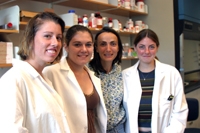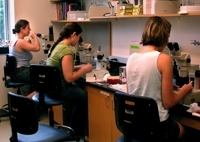Laura Batterink, Suzanne Czerniak and Kerry Krauss investigate the development of cows' eggs

MIDDLEBURY, Vt.-Middlebury College junior Laura Batterink and seniors Suzanne Czerniak and Kerry Krauss worked on campus this summer to investigate the development of cows’ eggs. The three students, under the direction of Middlebury College Associate Professor of Biology Catherine Combelles, were directly involved in collecting and testing oocytes from bovine ovaries for a research project titled “Influence of Oxidative Stress on Bovine Oocyte Maturation.”

Laura Batterink, Suzanne Czerniak and Kerry Krauss worked on campus this summer to investigate the development of cows’ eggs. Photo by Ari Joseph
An oocyte is a cell that can develop into an egg. During the stage of maturing into eggs, oocytes acquire the ability to further progress, once fertilized as eggs, into embryos that can sustain development to term. The variables of an oocyte’s growing stage toward becoming an egg will affect the egg’s ability to ultimately become a healthy fetus.
“We are interested in not only understanding what makes up a good quality oocyte, but also optimizing culture conditions for the maturation of oocytes in vitro,” said Combelles. “The relevance of our work pertains to the treatment of human infertility and improving embryo production, as well as the preservation of genetic material in, for instance, agriculturally important and endangered species.”
Batterink, Czerniak and Krauss collected test tubes of bovine ovaries from a local slaughterhouse to bring back to their lab for further handling. At the lab, they dissected the ovaries to isolate the oocyte cells, which they placed into various cultures for a 24-hour maturation period in an incubator. After the oocytes matured into eggs, the students processed and analyzed them under microscopes to see whether any key proteins had been expressed, and to check “spindle structures”-cellular constructions that allow chromosomes to successfully segregate.
“All our work involves studying how different factors related to the oxidative stress an oocyte experiences affect that particular oocyte’s viability,” explained Suzanne Czerniak, who double majors in English and biochemistry. “Basically, we’re going to take cow egg cells, expose them to different oxidative stress conditions, then use different tests to see which ones could potentially make a healthy embryo.”
According to Batterink, a neuroscience major, the experience in Combelles’ lab advances her ongoing study. “I’m a neuroscience major and focusing more on the psychology side of biology, the study of neurons rather than oocytes. However, since I want to go into lab research eventually, this experience is invaluable,” said Batterink. “I like working with Prof. Combelles-I’m learning a lot from her. We have as much flexibility and responsibility as possible, allowing us to work independently on the experiments while still referring back to her with questions whenever necessary. She’s very knowledgeable and enthusiastic, and it’s easy to see she loves what she does. This makes me excited about the research, too.”
Krauss, a biology major, discovered her interest in oocyte cells as an intern during the 2004 summer for the biology department at the University of Pennsylvania. She plans to base her senior thesis exploring why women 35-45 years old have more difficulty conceiving than do younger women, and why babies conceived by this age group have a higher tendency toward chromosomal abnormalities.
“The research is really interesting to me and I love working with oocytes. They represent the beginning of life, in a way,” said Krauss. “They are also just really cool looking cells. They’re perfectly spherical and, frankly just beautiful to look at. The whole process of conception and pregnancy is really fascinating. When you think about all the things that have to go right in order to create a baby, it’s impressive that anyone is able to get pregnant.”
Combelles and Krauss have been “thinking oocytes” together for the past year. “It has been most rewarding to watch her interest in developmental biology flourish,” Combelles said of Krauss. “And, I’m extremely grateful for her help. She has been instrumental in getting my new laboratory off to a great start.” Krauss received Middlebury College’s 2005 Janet C. Curry ‘49 Science Honors Award for her summer research proposal titled, “The Effect of Estrogen on the Expression of Antioxidant Enzymes, SOD1 and SOD2, during Bovine Oocyte Maturation.”
According to Combelles, who refered to her summer research assistants as “the ova squad,” the students’ work will contribute significantly to oocyte biology, a field with many aspects that remain ill-defined, by ultimately amassing preliminary data for ongoing investigation. Combelles appreciates the cooperative effort the students provide for other reasons, also: “It’s much more fun to work with students in the lab,” she said.
—end—

